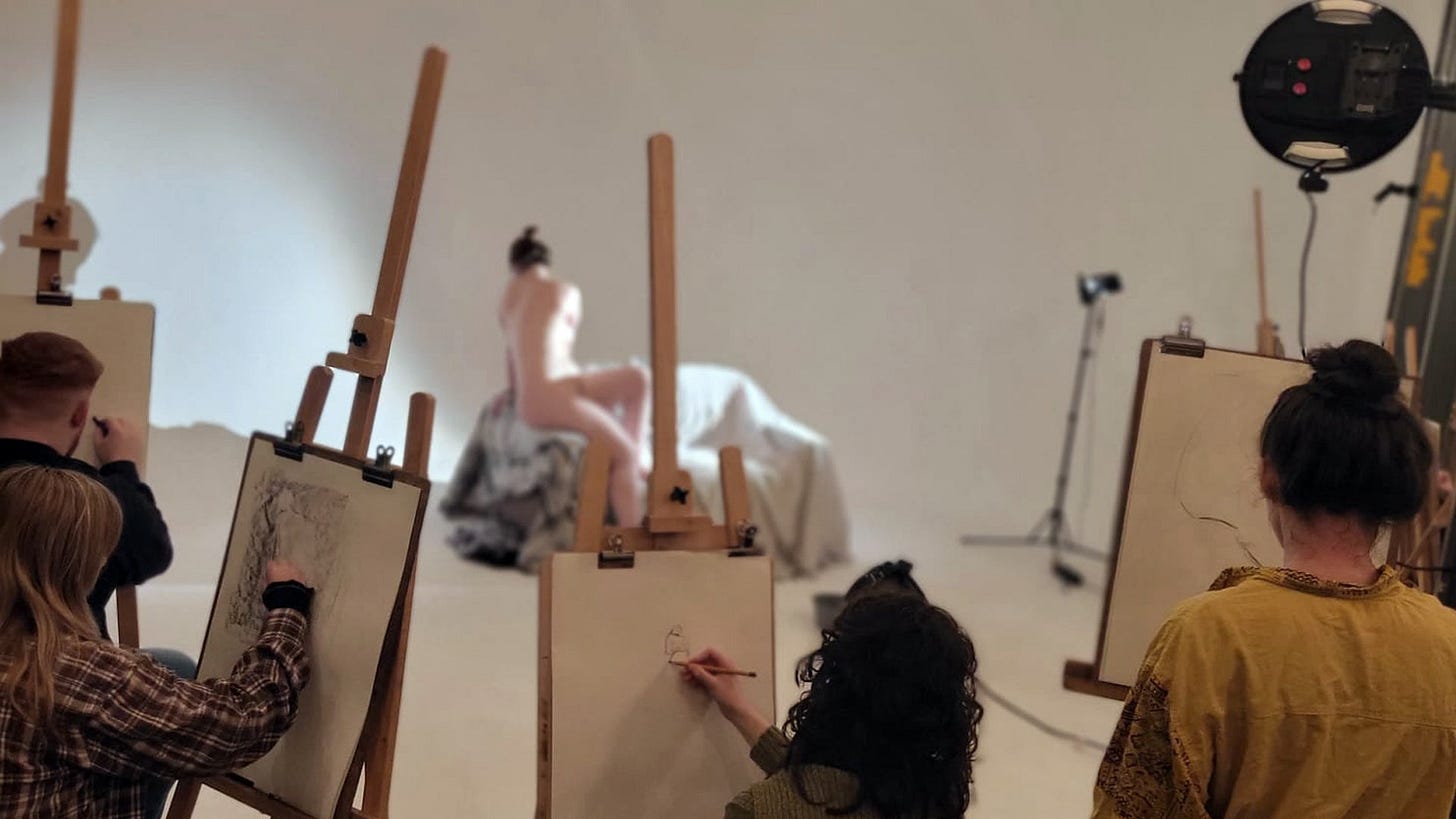Rebel with a Pencil: What Life Drawing Class Taught Me About Art and Sexism
Hidden biases and attitudes revealed by nakedness and the struggle to capture it accurately
Thanks so much for following my adventure in art class! Don’t forget to hit the ❤️ so I know you’re here! For context, read the previous essays on this experience if you care to:
This week, our slender, tattooed model returned to drawing class. Standing before her, powered up on chai tea and attitude, I felt confident. She struck what the master called a "heroic pose"—standing tall, gazing into the middle distance, holding a staff. With two full classes (six hours) to complete her portrait, I was sure I could get it right this time.
I diligently followed the master’s method—dividing the paper into fourths, identifying key reference points on her body to ensure my proportions were correct.
As I sketched, my eyes rested on their usual favorite parts: the ear, a delicate, lighted shell. The top of her slender thigh, a long, unbroken curve. The arc of her shoulder.
I found it easier to study her body than the male model’s from the previous class, and this puzzled me.
Then it hit me: my discomfort with drawing male models stemmed from deep social conditioning. I’ve been trained not to stare at men—it’s a known come-on. Keeping my eyes averted to avoid unwanted attention had become second nature.
Another realization bubbled up: women’s bodies are available for public consumption. We all look, comment, opine, and judge.
Men’s bodies? Not nearly as much, nor in the same way.
This cultural lens had shaped my reactions: I had stronger opinions about our female model’s form and body, while my response to the male one was neutral—or even shy.
Apparently, I’m sexist. Hard on other women. It hurt to know that. I want to be better. From now on, I will be.
The master, crackling with energy, was in a good mood that day. I’d resolved to keep a low profile—no funny quips or attempts at intellectual banter to prove I was smart or educated. I was determined to follow every rule and get it right. Be a good girl, as it were.
But immediately after quartering the paper, I was struggling. The model’s neck was too long, her torso too wide. Her belly button listed to the left. Her hands resembled tiny raccoon paws.
The master approached. “Hmm. Let’s investigate. If this is here, then this must be here.” He quickly identified the central problem. “You’re still over-focusing on individual parts.”
Tracing down the leg that looked mysteriously wrong, he spotted my original mark—the one showing where the figure was supposed to end. It was in the middle of the foot instead of beneath it.
“Aha! You went past the reference point. That throws all your dimensions off.”
One error had caused a cascade, turning my drawing into something distorted, Dali-esque.
“I didn’t realize it absolutely had to end at the mark. I thought it was… ambiguous,” I said. I like ambiguity in my art, in my writing too—layers, possibilities, nothing quite as it seems.
“You’re a rebel,” he said with a smile. “I see the problem now.”
My eyes widened in alarm.
Indeed I am a rebel, wrapped up in friendly, freckled, middle aged conformity camouflage.
Not only had he sussed out my real attitude and spotted my mistake—one I’d barely acknowledged myself—but had he been reading my newsletter? Anxiety prickled as I worried that he might read these posts and that I’d offend him.
I’m too concerned with offending. Truth exists. Sometimes it’s ugly, but it has to be said. This battle with resistance, this experience of self examination in his class—I’m doing my best to tell the truth about it.
That said, truth is subjective.
I remember the master saying early on, “There is no creativity in this class.” That felt like sacrilege, given my previous experiences with art instruction. But to say he didn’t believe in creativity would be wrong. The master believed in learning objective standards first—then experimenting.
I see the value in that; even Picasso was a realist before he went rogue with cubism.
Despite my resolution to lay low, I ended up in an intense conversation with him during a break as we talked about the evolution of art instruction. I told him I had a lifetime of hodgepodge training, and learning this new method has been hard. I wished I’d learned to quarter the paper, use a halving technique and a plumbline, when I was a teenager—not at fiftysomething.
“I guess everyone has to figure out their purpose in art,” I said.
“Exactly!” he exclaimed. “And everyone’s purpose is different.”
That’s what I’m trying to figure out too. But as long as I’m writing about the experience—mining for nuggets of learning and insight, grappling with challenges and fears—I’m getting my money’s worth.
Even if my drawings still disappoint.
And even if the master wrote MADS (Mass, Angles, Distance, Shapes) on my paper yet again. 🥹
Don’t forget to hit the ❤️ so I know you’re here, and thanks for reading! Leave a comment and let me know what you think about the observation of bodies of either gender?





It takes a strong character to put all your thoughts on paper. Exposing your discovery of bias is a great learning experience for all of us who read this. As I read it, it brought of my thoughts of what I would do in this case. Sadly, I would never have been brave enough to be in this situation. My twin was though, she took up painting china in her 50's and is now an excellent porcelain artist. She has always been the one who went first. Looking back I have seen how much I missed because of fear of failure.
I love all the life lessons you've captured here!